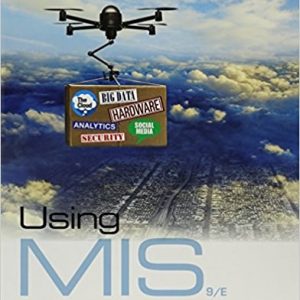Test Bank for Selling: Building Partnerships 10th Edition

Product details:
- ISBN-10 : 1259573206
- ISBN-13 : 978-1259573200
- Author: Stephen Castleberry
Selling: Building Partnerships, Tenth Edition remains the most innovative textbook in sales, featuring distinct role-plays, mini-case studies, and a focus on knowledge and skills critical to the partnership process and successful business professionals. Emphasized throughout is the need for salespeople to be flexible and adapt strategies that address customer needs, buyer social styles, and other relationship needs and strategies. This approach is followed by a thorough discussion of the salesperson as manager and how planning and continual learning enable effective selling and career growth. The text’s emphasis on value creation makes it applicable for students who may not be interested in a sales career. As has been true of every edition since the first, the integration of ethics continues to be emphasized.
Table contents:
- Chapter 1 Selling and Salespeople
- Why Learn about Personal Selling?
- Everyone Sells
- Creating Value: The Role of Salespeople in a Business
- What Do Salespeople Do?
- Client Relationship Manager
- Account Team Manager
- Supply Chain Logistics and Channel Manager
- Information Provider to Their Firm
- Types of Salespeople
- Selling and Distribution Channels
- Describing Sales Jobs
- The Sales Jobs Continuum
- Examples of Sales Jobs
- Characteristics of Successful Salespeople
- Self-Motivated
- Dependability and Trustworthiness
- Integrity and Ethical Sales Behavior
- Customer and Product Knowledge
- Analytical Skills and the Ability to Use Information Technology
- Communication Skills
- Flexibility and Agility
- Creativity
- Confidence and Optimism
- Emotional Intelligence
- Are Salespeople Born or Made?
- Rewards in Selling
- Independence and Responsibility
- Financial Rewards
- Management Opportunities
- The Building Partnerships Model
- Selling Yourself
- Summary
- Key Terms
- Ethics Problems
- Questions and Problems
- Case Problems
- Role Play Case
- Additional References
- Part 1 Knowledge and Skill Requirements
- Chapter 2 Ethical and Legal Issues in Selling
- Ethics and Selling
- The Evolution of Selling
- Ethics and Partnering Relationships
- Factors Influencing the Ethical Behavior of Salespeople
- Selling Ethics and Relationships
- Relationships with Customers
- Relationships with the Salesperson’s Company
- Relationships with Colleagues
- Relationships with Competitors
- Legal Issues
- Uniform Commercial Code
- Misrepresentation or Sales Puffery
- Illegal Business Practices
- International Ethical and Legal Issues
- Resolving Cultural Differences
- Legal Issues
- Selling Yourself
- Summary
- Key Terms
- Questions and Problems
- Case Problems
- Role Play Case
- Additional References
- Chapter 3 Buying Behavior and the Buying Process
- Why People Buy
- Types of Customers
- Manufacturers
- Resellers
- Government Agencies
- Institutions
- Consumers
- Organizational Buying and Selling
- Complexity of the Organizational Buying Process
- Derived versus Direct Demand
- How Do Organizations Make Buying Decisions?
- Steps in the Buying Process
- Creeping Commitment
- Types of Organizational Buying Decisions
- New Tasks
- Straight Rebuys
- Modified Rebuys
- Who Makes the Buying Decision?
- Users
- Initiators
- Influencers
- Gatekeepers
- Deciders
- Supplier Evaluation and Choice
- Organizational Needs and Criteria
- Individual Needs of Buying Center Members
- Supply Chain Management and Professional Purchasing
- Supply Chain Management
- Multiattribute Model of Product Evaluation and Choice
- Performance Evaluation of Characteristics
- Importance Weights
- Overall Evaluation
- Value Offered
- Supplier Selection
- Implications for Salespeople
- Selling Yourself
- Summary
- Key Terms
- Ethics Problems
- Questions and Problems
- Case Problems
- Role Play Case
- Additional References
- Chapter 4 Using Communication Principles to Build Relationships
- Building Relationships through Two-Way Communication
- The Communication Process
- Communication Breakdowns
- Sending Verbal Messages Effectively
- Choice of Words
- Voice Characteristics
- Stories
- Keep Open Lines of Communication
- Active Listening
- Repeating Information
- Restating or Rephrasing Information
- Clarifying Information
- Summarizing the Conversation
- Tolerating Silences
- Concentrating on the Ideas Being Communicated
- Reading Nonverbal Messages from Customers
- Body Angle
- Face
- Arms
- Hands
- Legs
- Body Language Patterns
- Sending Messages with Nonverbal Communication
- Using Body Language
- The Role of Space and Physical Contact
- Appearance
- Communicating via Technology
- Telephone and Voice Mail
- Text Messages and E-mail
- Social Media
- Adjusting for Cultural Differences
- Selling Yourself
- Summary
- Key Terms
- Ethics Problems
- Questions and Problems
- Case Problems
- Role Play Case
- Additional References
- Chapter 5 Adaptive Selling for Relationship Building
- Types of Presentations
- Standard Memorized Presentation
- Outlined Presentation
- Customized Presentation
- Adaptive Selling and Sales Success
- Adaptive Selling: The Importance of Knowledge
- Product and Company Knowledge
- Knowledge about Sales Situations and Customers
- How to Create Knowledge
- Retrieving Knowledge from the Knowledge Management System
- The Social Style Matrix: A Training Program for Building Adaptive Selling Skills
- Dimensions of Social Styles
- Categories of Social Styles
- Identifying Customers’ Social Styles
- Social Styles and Sales Presentations
- Versatility
- Recap: The Role of Knowledge in Adapting
- Systems for Developing Adaptive Selling Skills
- Selling Yourself
- Summary
- Key Terms
- Ethics Problems
- Questions and Problems
- Case Problems
- Role Play Case
- Additional References
- Part 2 The Partnership Process
- Chapter 6 Prospecting
- The Importance of Prospecting
- Characteristics of a Good Prospect
- Does a Want or Need Exist?
- Does the Lead Have the Ability to Pay?
- Does the Lead Have the Authority to Buy?
- Can the Lead Be Approached Favorably?
- Is the Lead Eligible to Buy?
- Other Criteria
- How and Where to Obtain Prospects
- Satisfied Customers
- Endless-Chain Method
- Networking and Center of Influence
- Social Media
- Other Internet Uses
- Marketing Department
- Shows, Fairs, and Merchandise Markets
- Webinars and Seminars
- Lists and Directories
- Databases and Data Mining
- Cold Calling
- Spotters
- Inside Salespeople
- Expertise
- Sales Letters
- Other Sources of Leads
- Lead Qualification and Management Systems
- Overcoming a Reluctance to Prospect
- Selling Yourself
- Summary
- Key Terms
- Ethics Problems
- Questions and Problems
- Case Problems
- Role Play Case
- Additional References
- Chapter 7 Planning the Sales Call
- Why Plan the Sales Call?
- Obtaining Precall Information
- The Prospect/Customer as an Individual
- The Prospect’s/Customer’s Organization
- Sources of Information
- Resources within Your Company
- The Internet and Social Media
- Secretaries and Receptionists
- Noncompeting Salespeople
- Traditional Secondary Sources
- The Prospect
- Other Sources
- Setting Call Objectives
- Criteria for Effective Objectives
- Setting More Than One Call Objective
- Setting Objectives for Several Calls
- Buyers Are Setting Goals Also
- Making an Appointment
- The Right Person
- The Right Time
- The Right Place
- Cultivating Relationships with Subordinates
- Telephoning for Appointments
- Additional Planning
- Selling Yourself
- Summary
- Key Terms
- Ethics Problems
- Questions and Problems
- Case Problems
- Role Play Case
- Additional References
- Chapter 8 Making the Sales Call
- Making a Good Impression
- Waiting for the Prospect
- First Impressions
- Selecting a Seat
- Getting the Customer’s Attention
- Developing Rapport
- When Things Go Wrong
- Identifying the Prospect’s Needs: The Power of Asking Questions
- Asking Open and Closed Questions
- Spin® Technique
- Reiterating Needs You Identified before the Meeting
- Additional Considerations
- Developing a Strategy for the Presentation
- Offering Value: The Solution to the Buyer’s Needs
- Relating Features to Benefits
- Assessing Reactions
- Building Credibility during the Call
- Selling to Groups
- Selling Yourself
- Summary
- Key Terms
- Ethics Problems
- Questions and Problems
- Case Problems
- Role Play Case
- Additional References
- Chapter 9 Strengthening the Presentation
- Characteristics of a Strong Presentation
- Keeps the Buyer’s Attention
- Improves the Buyer’s Understanding
- Helps the Buyer Remember What Was Said
- Offers Proof of the Salesperson’s Assertions
- Creates a Sense of Value
- How to Strengthen the Presentation
- Verbal Tools
- Visual Tools
- Product Demonstrations
- Handouts
- Written Proposals
- Value Analysis: Quantifying the Solution
- Dealing with the Jitters
- Selling Yourself
- Summary
- Key Terms
People also search:
selling building partnerships 10th edition
can you sell a partnership business
what is partnership selling
partnership selling examples
10 examples of partnership business





